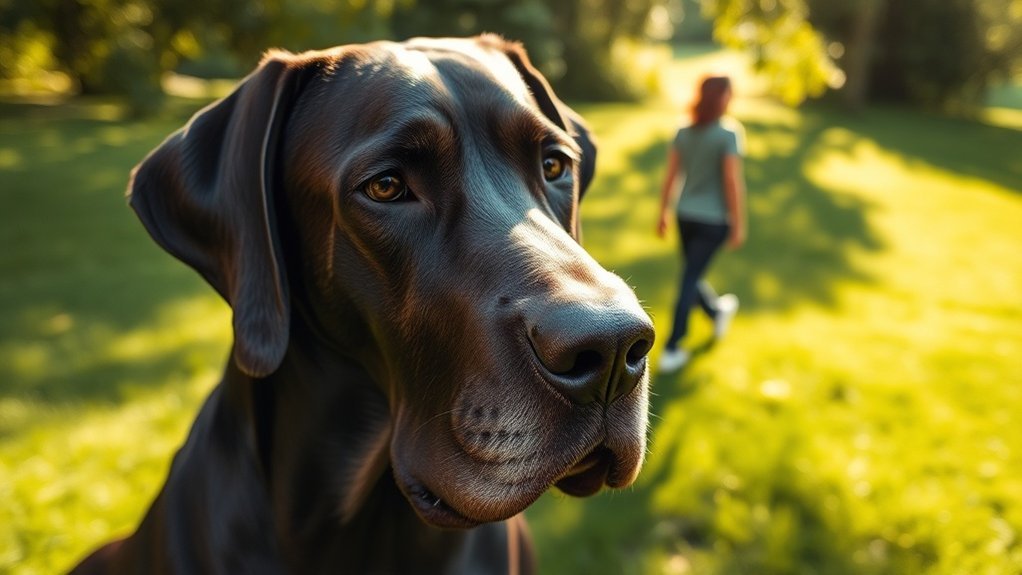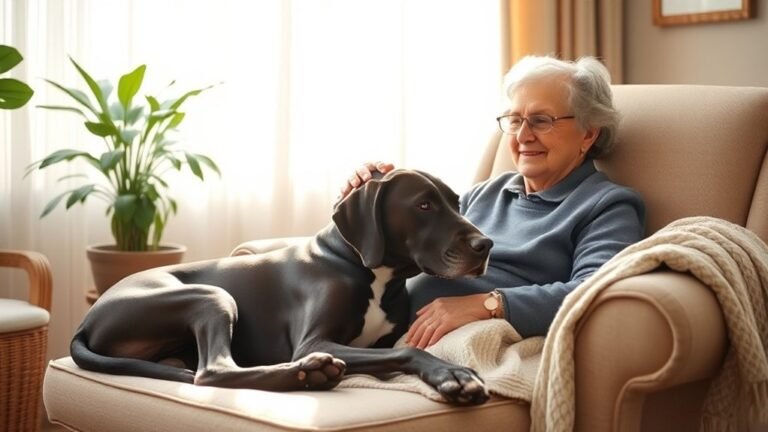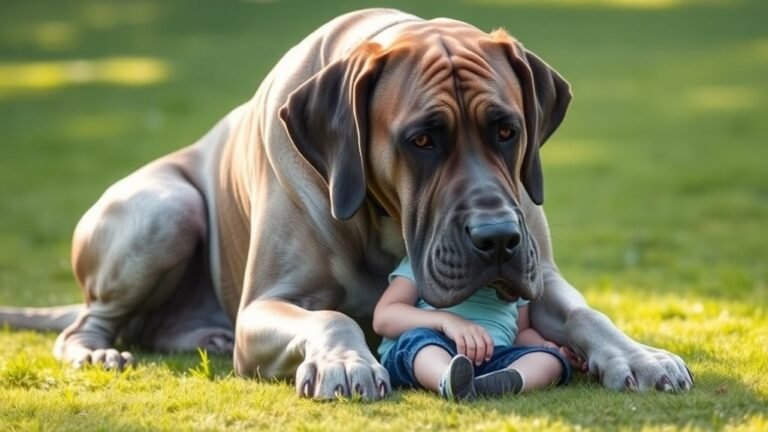Why Does a Great Dane Follow You
Why Does My Great Dane Follow Me
Why do I follow you around everywhere? Well, let me explain from my perspective as your lovable Great Dane!
First off, I absolutely adore you! You’re my favorite human, and I want to be near you all the time. Think of me as your furry best friend who happens to be the size of a small horse. When I follow you from room to room, it’s because I genuinely enjoy your company and don’t want to miss out on anything exciting you might be doing.
Sometimes I follow you because I’m looking for attention or reassurance. If something seems scary or different, you make me feel safe and secure. You’re like my personal superhero! When there are loud noises or unfamiliar people around, sticking close to you helps me feel much better about the situation.
I also follow you because, let’s be honest, I’m hoping something interesting will happen. Maybe you’re heading to the kitchen where magical food appears, or perhaps you’re going outside where I can run around and stretch my long legs. My brain needs stimulation just like my body needs exercise, so following you around is like my daily entertainment.
Being your loyal shadow is just part of who I am. I want to make sure you’re okay and that nothing bad happens to you. After all, you’re the one who feeds me, gives me belly rubs, and tells me I’m a good boy. That’s worth protecting!
Attachment and Affection
When my humans think about our bond, they get all mushy about attachment and stuff. But let me tell you what’s going on from my end! I’m a 150-pound shadow with floppy ears and zero personal space awareness.
My humans get all mushy about our bond, but really, I’m just a 150-pound shadow with zero personal space!
Those “bonding rituals” they talk about? Yeah, that’s just me making sure they don’t disappear forever when they grab the leash. Daily walks are my chance to supervise their sniffing skills (they’re terrible at it) and make sure they don’t get lost without my guidance.
Playtime is when I generously let them throw things so I can show off my graceful galloping – and by graceful, I mean I only knock over three pieces of furniture instead of five.
My humans think I’m “incredibly intuitive” about their emotions. Really, I have a sixth sense for when someone needs a 150-pound lap dog. Feeling sad? Here comes my giant head on your shoulder. Having a bad day? Time for me to lean my entire body weight against your legs until you can’t move.
It’s not emotional support – it’s strategic positioning for maximum attention and treats.
This whole “following closely” thing they mention? Look, I’m not being clingy. I’m just making sure they don’t do anything stupid without proper Great Dane supervision. Someone has to keep an eye on these humans, and clearly, I’m the most qualified candidate in this house. Understanding body language helps me know exactly when to step in and provide my special brand of companionship.
Desire for Attention and Reassurance
We Great Danes love hanging out with our humans because we need to chat and connect with you! Our need for attention isn’t just because we want a buddy to chill with – though that’s pretty awesome too.
It’s actually how we tell you what we’re thinking and feeling. Think about it this way: when I follow you around the house like a furry shadow, I’m saying, “Hey! Pay attention to me!” Maybe I need to go outside, or I’m hungry, or I just want some belly rubs.
Sometimes I just want to make sure you’re still there because, let’s be honest, you humans can be pretty sneaky when you disappear.
When you understand that my attention-seeking isn’t me being annoying (okay, maybe sometimes it is), but actually me trying to communicate, it makes our friendship even stronger.
Plus, it helps me feel safe and essential in our pack. And trust me, nothing makes a Great Dane happier than feeling like the most important giant baby in the house! Regular exercise and mental stimulation techniques can also help reduce any anxiety I might feel when I’m following you around.
Need for Interaction
Hi there! I’m a Great Dane, and let me tell you something – I might be huge, but I’m a giant teddy bear who just wants to hang out with you all the time.
Sure, I look pretty impressive when I’m standing next to you (okay, maybe towering over you), but here’s my secret: I’m actually super sensitive and I need lots of love and attention. I know, I know – it’s pretty funny that something my size gets worried about whether you still like me, but that’s just how we Great Danes roll!
You know how I follow you everywhere? From the kitchen to the bathroom to the mailbox? That’s not because I’m being nosy (well, maybe a little). It’s because I want to spend time with you! When you’re around, I feel safe and happy. It’s like having my favorite person right there makes everything better.
Sometimes my humans think I’m being clingy, but I prefer to call it “being an excellent companion.” When you pet me or talk to me, my whole day gets brighter. It makes me feel like I belong in this family, which is pretty much the best feeling ever. Plus, early socialization helps me become a well-adjusted adult, allowing me to bond better with you!
Communication of Needs
Hey there, humans! Let me tell you how us Great Danes let you know what we need. We’re pretty smart cookies, and we’ve got our special ways of getting your attention.
First off, we’re masters of the lean. When I plop my massive body against your leg, I’m saying, “Hey, notice me!” It’s like a gentle bulldozer move, except with more love and less construction work.
Sometimes I’ll rest my giant head right in your lap, which is my way of saying “Pet me now, please!” Sure, your legs might go numb, but that’s a small price to pay for Great Dane cuddles, right?
We’re also pretty chatty when we want to be. My soft whines aren’t complaining – they’re more like polite requests. Think of them as my version of saying, “Excuse me, but could I get some attention over here?”
And those gentle barks? That’s me trying to start a conversation. I mightn’t speak human, but I’ve got plenty to say!
The best part is when you actually pay attention to these signals. It makes me feel understood, like we’re having a real conversation.
When you understand what I’m trying to say, it makes both of us happy. Plus, I feel way more secure knowing my favorite human actually gets me. Effective training methods foster loyalty and build trust, making it easier for us to communicate our needs!
Trust me, once you learn our Great Dane language, we’ll be the best of friends!
Anxiety and Security Seeking
When I follow you around everywhere, it’s because sometimes this big world makes me feel a little worried! I know I’m huge – trust me, I bump into things all the time – but loud sounds and new places can make my tail tuck between my legs. That’s when I need to stick close to my favorite humans.
You guys are like my security blanket, except way better because you give belly rubs! When the garbage truck rumbles down the street or strangers come to visit, I feel so much calmer when I can see you or lean against your legs. Sure, I might knock you over sometimes – whoops! – but being near you makes everything okay.
You’re my comfort when the world feels big and scary, making everything okay with your belly rubs and warm presence.
I appreciate it when you notice I’m feeling stressed out. Those yummy treats you give me when I’m being brave? Pure genius! And that cozy spot you made for me in the corner? It’s perfect for when I need to chill out and remember that everything’s fine. Common noises can make me anxious, so I’m grateful when you help me through those moments.
The best part is that when you understand why I’m being your four-legged shadow, it makes us even better friends. I promise I’m not trying to trip you when I follow you to the bathroom – I want to make sure my favorite person is safe too! Plus, someone needs to guard you while you’re in there, right?
Temperature Regulation and Physical Comfort
Hey there, human! Let me tell you why I’m your giant, furry shadow when the weather gets weird.
But here’s what’s funny: even though I’m the size of a small horse, I get cold and hot just like you do. Actually, maybe even worse! My big body is like a temperature drama queen that can’t make up its mind.
When it’s cold outside, you’ll find me glued to your side like I’m your bodyguard. But really? I’m just trying to steal your warmth! Don’t take it personally – I’m not being clingy, I’m being smart. Your cozy spot on the couch suddenly becomes MY cozy spot on the couch. Sorry, not sorry!
And when summer hits? Oh boy, now I’m following you to find the coolest spots in the house. That nice air-conditioned room you’re in? Perfect! I’ll just plop my 150-pound self right next to you and pant dramatically until you notice how overheated I am.
The truth is, I’m not just following you around because I love you (though I totally do). I’m also using you as my climate control system! You always seem to know where the perfect temperature spots are, so I figure – why not tag along?
Plus, hanging out with you makes me feel safe and happy, which is like a bonus comfort level. And don’t forget, being around you helps me enjoy my daily exercise routines, keeping both of us active and healthy!
Protective and Guarding Instincts
As a Great Dane, I take my job as your bodyguard very seriously! When we’re hanging out together, my protective instincts are always on high alert. It’s like I’ve a built-in security system that never takes a coffee break.
I’m naturally wired to be your furry guardian. Think of me as a tall, slobbering superhero who happens to love belly rubs. My job is to keep you safe and watch over our home turf. When I hear something suspicious (like the mailman or a leaf falling), I’ll let you know with my impressive bark. You’re welcome!
When I follow you around the house like a giant shadow, I’m not being clingy – I’m being professional! I need to ensure your safety, whether you’re going to the kitchen, the bathroom, or simply moving from the couch to the chair.
You never know when danger might strike, like a vacuum cleaner appearing out of nowhere.
My protective nature isn’t just about being tough, though. It’s my way of showing how much I care about you. We’re a team, and I’ve got your back (literally, since I’m usually right behind you). Additionally, my loyalty and affection are traits typical of Great Dane characteristics, making our bond even more special.
Understanding that I’m just looking out for you helps make our friendship even stronger. Plus, it gives me a good excuse to stick close and maybe score some extra treats along the way!
Energy Levels and Exercise Needs
Hey there, humans! It’s me, your friendly neighborhood Great Dane, and I need to talk to you about something super important – my energy levels and exercise needs!
Now, I know what you’re thinking. “But you’re HUGE! You must need to run marathons every day!” Well, hold your horses (or should I say, keep your Great Danes?). The truth is, we gentle giants are kind of like huge couch potatoes with occasional bursts of “ZOOMIES!”
Here’s the deal – I’m not a Border Collie who needs to herd sheep all day. I’m more like that friend who loves a good walk around the block followed by a three-hour nap on our favorite couch. But here’s the catch: if you don’t give me enough fun stuff to do, I might get bored. And trust me, you don’t want a bored Great Dane!
When I’m bored, I turn into a four-legged tornado. I might decide your shoes look delicious, or that digging a swimming pool in your backyard sounds like a fantastic idea. I could also develop what I like to call “indoor zoomies,” where I race around your house like I’m competing in the Dane 500.
What I really need is about 30-60 minutes of exercise each day. A nice walk, some playtime in the yard, or a game of fetch works perfectly. Just remember – I’m still growing until I’m about two years old, so don’t make me run too much or my joints might get cranky.
The secret to keeping me happy? Mix it up! Mental exercise is just as important as physical exercise. Hide treats around the house, teach me new tricks, or give me puzzle toys. My brain needs workouts too! Regular veterinary check-ups are also essential to monitor my health and ensure I’m staying fit as I grow.
Exercise Requirements Explained
Hey there, humans! It’s me, your friendly neighborhood Great Dane, and I need to talk to you about something super important – my exercise needs! Trust me, keeping this giant body happy isn’t as easy as it looks.
Daily Walks Are My Thing: Listen up, two-legs! I need at least 30-60 minutes of walking every single day.
Plus, walking gives me time to sniff every single tree, fire hydrant, and suspicious blade of grass in the neighborhood. It’s like reading the daily newspaper, but way more interesting!
Playtime Makes Me Smart: Throw me a ball and watch magic happen! Games like fetch don’t just tire out my body – they make my brain work too.
I’ve to figure out where that ball went, remember to bring it back (sometimes I forget this part), and calculate the perfect jumping technique. It’s like doggy math, and I’m pretty good at it!
Adventure Time!: Dog parks and hiking trails? YES PLEASE! I love meeting new furry friends and showing off how tall I am.
At the dog park, I’m like the gentle giant who accidentally photobombs everyone’s pictures. On hiking trails, I get to be an explorer, even though I sometimes need to rest more than those tiny, energetic dogs.
Keep It Regular: Just like you humans need your morning coffee, I need my daily exercise routine.
It keeps me from getting the zoomies at 2 AM and turning your living room into my racetrack. Trust me, nobody wants a 150-pound dog doing laps around the coffee table!
Boredom and Hyperactivity Issues
When we Great Danes don’t get enough exercise, boy oh boy, do things get interesting around here! I’m talking full-blown boredom mode, and trust me, you don’t want to see what happens next.
Picture this: I’m sitting there with all this energy bubbling up inside me like a shaken soda can. What’s a giant dog to do? Well, I might start barking at absolutely everything – the mailman, that suspicious squirrel, even my own shadow.
Sometimes I’ll find the nearest shoe and think, “This looks like a perfect chew toy!” Or maybe I’ll decide the backyard needs some landscaping and start digging holes like I’m searching for buried treasure.
My humans call this “pent-up energy,” but I call it “the zoomies with nowhere to go.” It’s like having an itch you can’t scratch, except the itch is in my brain and my paws at the same time.
The good news? My humans have come up with some pretty nifty solutions. They take me on long walks where I can sniff every interesting smell (and there are SO many).
They’ve gotten me puzzle toys that make me work for my treats – it’s like being a detective, but for food!
Sometimes we even do agility training, which is an obstacle course where I get to show off how graceful a 150-pound dog can be (spoiler alert: it’s hilarious).
When I get enough exercise and brain games, I transform from a four-legged tornado into the perfect couch companion.
Plus, all these activities mean more quality time with my favorite humans, which makes my tail wag so hard it could power a small fan!
Final Thoughts
First off, I absolutely love my human. They’re like the best thing since squeaky toys were invented! When I follow them around the house, it’s because I genuinely enjoy their company. Plus, they might drop food at any moment – and trust me, I don’t want to miss that golden opportunity.
I also feel way safer when I’m near my favorite person. Sure, I’m huge and could probably scare off a burglar just by existing, but deep down, I’m a giant lap dog who gets nervous when left alone. My human makes me feel secure, so I stick close by.
There’s also this ancient dog instinct thing going on. My wolf ancestors lived in packs, and even though I’m about as far from a wolf as a poodle is from a lion, I still have those pack feelings. My human is my pack leader, so naturally, I want to be where they are.
Take me, for example – I follow my human Sarah everywhere. Kitchen? I’m there. Bathroom? Yep, I’m probably blocking the doorway. Laundry room? You bet I’m “helping” by getting in the way. It makes me happy, keeps our friendship strong, and hey, someone needs to protect her from dangerous things like the vacuum cleaner!
Understanding why I do this helps Sarah take better care of me, and it makes our friendship even more awesome.
References
- https://www.dogster.com/dog-health-care/when-will-my-great-dane-calm-down
- https://articles.hepper.com/why-does-my-great-dane-lean-on-me/
- https://greatdanecare.com/why-do-great-danes-lean-on-you/
- https://wagwalking.com/behavior/why-do-great-danes-pace
- https://www.purelypetsinsurance.co.uk/blogs/why-do-great-danes-bury-their-heads/






25 Comments